
Law Of Equal Areas
The Law of Equal Areas states that an imaginary line drawn from a planet to the sun sweeps out equal areas in equal periods of time. This means that a planet moves faster when it is closer to the sun and slower when it is farther away. This law was first described by Johannes Kepler in the early 17th century and is one of the three laws of planetary motion. The Law of Equal Areas is important in space and astronautical engineering because it helps scientists and engineers to calculate the trajectories of spacecraft and satellites as they orbit around planets and other celestial bodies.
Your Previous Searches
Random Picks
- Standardized Components: Standardized components refer to the use of common and interchangeable parts in the design and construction of spacecraft and other space systems. This approach allows for greater efficiency and cost-effectiveness in the manufacturing and m ... Read More >>
- Crop Calendar: A crop calendar is a schedule of the planting, growing, and harvesting of crops in a specific region. It takes into account the local climate, soil conditions, and other factors that affect crop growth. The calendar is used to plan and mana ... Read More >>
- Ambient Temperature: Ambient temperature refers to the temperature of the surrounding environment. In the context of space and astronautical engineering, ambient temperature is an important factor to consider when designing and operating spacecraft and other sp ... Read More >>
Top News

Bestselling author explains the science of happiness: "You can do the work"...
Bestselling author and Harvard professor Arthur Brooks opens up about how enjoyment, satisfaction and meaning in life can increase a person's wellbeing....
News Source: CBS News on 2024-11-18

November's full moon, known as the Beaver Moon, is the last supermoon of 2024. H...
November's full moon, known as the Beaver Moon, is the last supermoon of 2024. Here's when it peaks and why it's called the Beaver Moon....
News Source: CBS News on 2024-11-15

You can't put a price on the sense of awe particle physics inspires...
Astronomy and particle physics are no longer seen as vital by the US establishment, so funding has fallen. But our work creates a sense of wonder, and wonder matters, says Chanda Prescod-Weinstein...
News Source: New Scientist on 2024-11-13

If you want to stretch your gift game into days this holiday, check out these ad...
The advent calendar phenomenon is growing every year, with so many exciting, fun, beautiful, and delicious options available...
News Source: ABC News on 2024-11-04

November brings a bonanza of meteor showers...
November brings a skywatching bonanza, with three meteor showers — the Southern Taurids, Northern Taurids and Orionids — offering chances to see shooting stars....
News Source: NBC News on 2024-11-02